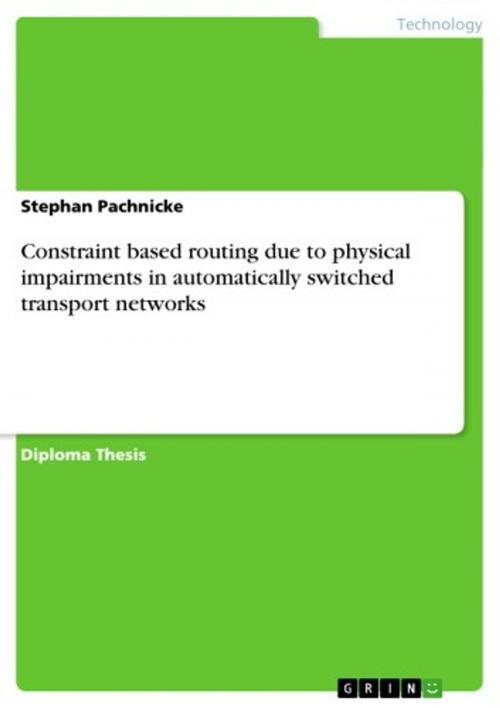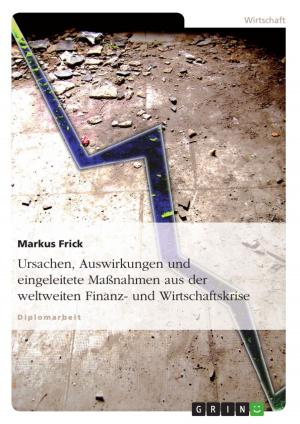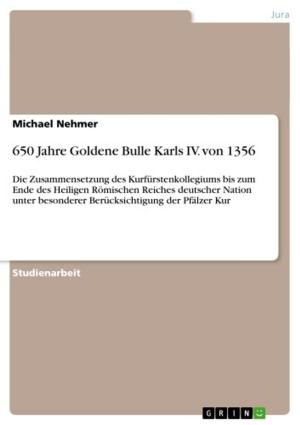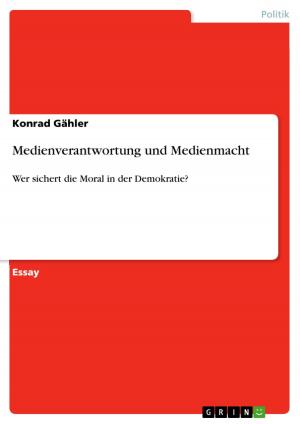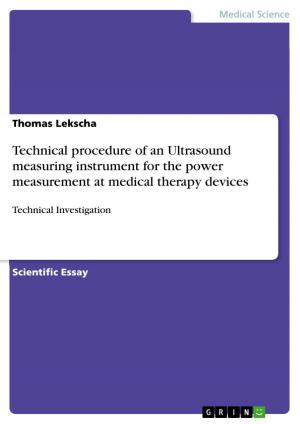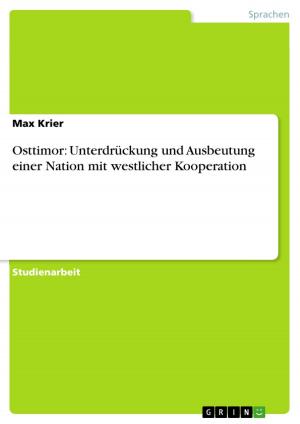Constraint based routing due to physical impairments in automatically switched transport networks
Nonfiction, Science & Nature, Technology, Electricity| Author: | Stephan Pachnicke | ISBN: | 9783638464222 |
| Publisher: | GRIN Publishing | Publication: | February 2, 2006 |
| Imprint: | GRIN Publishing | Language: | English |
| Author: | Stephan Pachnicke |
| ISBN: | 9783638464222 |
| Publisher: | GRIN Publishing |
| Publication: | February 2, 2006 |
| Imprint: | GRIN Publishing |
| Language: | English |
Diploma Thesis from the year 2002 in the subject Electrotechnology, grade: 1,0, University of Dortmund (Lehrstuhl für Hochfrequenztechnik), 39 entries in the bibliography, language: English, abstract: Next generation optical communication systems will be characterized by increasing data rates, high signal powers and dense wavelength division multiplexing (DWDM). In future-optical networks channels will be routed through complex, meshed networks (ASTN, Automatically Switched Transport Networks, ITU-T Recommendation G.808 0/Y.1304). These networks will be able to setup transparent optical paths without converting the optical signals to electrical signals. In all-optical networks the physical impairments and degradation effects play an important role. There is a multitude of degradation effects like dispersion, noise, crosstalk, fiber nonlinearities, polarization dependent loss, etc. To enable a fast setup and the best choice of one of the available paths, the signal quality along the whole transmission distance has to be evaluated very fast. Ideally, only a single figure of merit (FOM), e.g. the bit error rate (BER), will be computed, which incorporates all degradation effects. Therefore it is important to characterize the different physical impairments analytically. Signal distortions can be measured by an eye opening penalty (EOP) and degradation effects due to noise by the optical signal-to-noise ratio (OSNR). The goal is to find and calculate these impairments from the signal parameters (modulation format, data rate, duty cycle, channel spacing, etc.) as well as the route parameters (fiber lengths and parameters, EDFA powers, etc.). Due to the need of fast routing algorithms, time-consuming numerical methods or a complete system simulation are not practical. In addition, it is not possible to linearly accumulate the different degradation effects. The focus of this work is to find analytical or heuristic formulas for each degradation effect. These approximation formulas are compared to the results obtained from a complete simulation of a reference system with the help of the simulation tool PHOTOSS.
Stephan Pachnicke wurde 1977 in Dortmund geboren. Von 2000-2001 absolvierte er ein Masterstudium in 'Information Engineering' an der City University, London, Großbritannien. Sein Studium der Elektrotechnik an der TU Dortmund schloss er 2002 mit dem Grad Dipl.-Ing. ab. 2005 wurde er zum Dr.-Ing. der Elektrotechnik promoviert - ebenfalls an der TU Dortmund. Im Jahr 2005 beendete er außerdem ein Dipl.-Wirt.-Ing. Studium an der FernUniversität, Hagen. Seine Habilitation wurde ihm im Januar 2012 verliehen für Forschungsarbeiten über 'Optische Übertragungsnetze'. Gleichzeitig wurde er zum 'Privatdozent' der TU Dortmund ernannt. Von 2007 bis 2011 arbeitete er als Oberingenieur am Lehrstuhl für Hochfrequenztechnik, TU Dortmund. Anschließend war er bei der Firma ADVA Optical Networking SE in der Abteilung 'Advanced Technology' (CTO Office) beschäftigt und leitete u.a. EU-finanzierte Forschungsprojekte zu optischen Zugangsnetzten der nächsten Generation. Außerdem erforschte er Konzepte für die Konvergenz von Fest- und Mobilfunknetzen sowie Datenzentren der nächsten Generation. Seit 2016 ist er Professor an der Christian-Albrechts-Universität zu Kiel und leitet den Lehrstuhl für Nachrichtenübertragungstechnik. Gleichzeitig ist er Direktor des Instituts für Elektrotechnik und Informationstechnik. Er ist Autor bzw. Ko-Autor von mehr als 100 wissenschaftlichen Veröffentlichungen, darunter 5 Bücher und 19 Zeitschriftenbeiträge. Stephan Pachnicke erhielt verschiedene Auszeichnungen für seine wissenschaftliche Arbeit darunter den ITG-Preis 2012 des VDE, den Dissertationspreis 2006 der TU Dortmund sowie den VDE Preis Rhein/Ruhr 2002. Er ist Mitglied des VDE/ITG und Senior Member des IEEE.
Diploma Thesis from the year 2002 in the subject Electrotechnology, grade: 1,0, University of Dortmund (Lehrstuhl für Hochfrequenztechnik), 39 entries in the bibliography, language: English, abstract: Next generation optical communication systems will be characterized by increasing data rates, high signal powers and dense wavelength division multiplexing (DWDM). In future-optical networks channels will be routed through complex, meshed networks (ASTN, Automatically Switched Transport Networks, ITU-T Recommendation G.808 0/Y.1304). These networks will be able to setup transparent optical paths without converting the optical signals to electrical signals. In all-optical networks the physical impairments and degradation effects play an important role. There is a multitude of degradation effects like dispersion, noise, crosstalk, fiber nonlinearities, polarization dependent loss, etc. To enable a fast setup and the best choice of one of the available paths, the signal quality along the whole transmission distance has to be evaluated very fast. Ideally, only a single figure of merit (FOM), e.g. the bit error rate (BER), will be computed, which incorporates all degradation effects. Therefore it is important to characterize the different physical impairments analytically. Signal distortions can be measured by an eye opening penalty (EOP) and degradation effects due to noise by the optical signal-to-noise ratio (OSNR). The goal is to find and calculate these impairments from the signal parameters (modulation format, data rate, duty cycle, channel spacing, etc.) as well as the route parameters (fiber lengths and parameters, EDFA powers, etc.). Due to the need of fast routing algorithms, time-consuming numerical methods or a complete system simulation are not practical. In addition, it is not possible to linearly accumulate the different degradation effects. The focus of this work is to find analytical or heuristic formulas for each degradation effect. These approximation formulas are compared to the results obtained from a complete simulation of a reference system with the help of the simulation tool PHOTOSS.
Stephan Pachnicke wurde 1977 in Dortmund geboren. Von 2000-2001 absolvierte er ein Masterstudium in 'Information Engineering' an der City University, London, Großbritannien. Sein Studium der Elektrotechnik an der TU Dortmund schloss er 2002 mit dem Grad Dipl.-Ing. ab. 2005 wurde er zum Dr.-Ing. der Elektrotechnik promoviert - ebenfalls an der TU Dortmund. Im Jahr 2005 beendete er außerdem ein Dipl.-Wirt.-Ing. Studium an der FernUniversität, Hagen. Seine Habilitation wurde ihm im Januar 2012 verliehen für Forschungsarbeiten über 'Optische Übertragungsnetze'. Gleichzeitig wurde er zum 'Privatdozent' der TU Dortmund ernannt. Von 2007 bis 2011 arbeitete er als Oberingenieur am Lehrstuhl für Hochfrequenztechnik, TU Dortmund. Anschließend war er bei der Firma ADVA Optical Networking SE in der Abteilung 'Advanced Technology' (CTO Office) beschäftigt und leitete u.a. EU-finanzierte Forschungsprojekte zu optischen Zugangsnetzten der nächsten Generation. Außerdem erforschte er Konzepte für die Konvergenz von Fest- und Mobilfunknetzen sowie Datenzentren der nächsten Generation. Seit 2016 ist er Professor an der Christian-Albrechts-Universität zu Kiel und leitet den Lehrstuhl für Nachrichtenübertragungstechnik. Gleichzeitig ist er Direktor des Instituts für Elektrotechnik und Informationstechnik. Er ist Autor bzw. Ko-Autor von mehr als 100 wissenschaftlichen Veröffentlichungen, darunter 5 Bücher und 19 Zeitschriftenbeiträge. Stephan Pachnicke erhielt verschiedene Auszeichnungen für seine wissenschaftliche Arbeit darunter den ITG-Preis 2012 des VDE, den Dissertationspreis 2006 der TU Dortmund sowie den VDE Preis Rhein/Ruhr 2002. Er ist Mitglied des VDE/ITG und Senior Member des IEEE.
